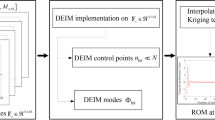Abstract
In flutter tests, particularly in wind tunnel experiments, the aircraft model is generally excited by atmospheric turbulence, which increases the difficulty in precisely identifying the modal parameters. To estimate the modal parameters under turbulence excitation for flutter boundary prediction, a technique was developed and evaluated depending on the Hilbert-Huang transform in this paper. The results of simulated flutter cases show that the developed technique can identify modal frequencies more precisely than the modal damping ratio, while the estimation of the modal damping ratio is quite good. Finally, in a wind tunnel flutter test, good flutter boundaries were predicted in advance by using the modal parameters identified from the turbulence response at low airspeeds.
Similar content being viewed by others
Abbreviations
- x(t):
-
Response
- P :
-
Cauchy principal value
- A (t):
-
Instantaneous amplitude
- θ(t):
-
Instantaneous phase
- ω(t):
-
Instantaneous frequency
- ω j :
-
jth modal frequency
- ζ j :
-
jth modal damping ratio
- ω j :
-
jth modal frequency
- V :
-
Airspeed
- B :
-
Polynomial coefficient
- C :
-
Polynomial coefficient
- D :
-
Polynomial coefficient
- FM :
-
Flutter margin
- F z :
-
Flutter criterion
References
E. H. Dowell et al., A Modern Course in Seroelasticity, Kluwer Academic, Norwell, MA (2005).
A. Kayran, Flight flutter testing and aeroelastic stability of aircraft, Aircraft Engineering and Aerospace Technology, 79(5) (2007) 494–506.
R. Huang, Y. H. Zhao and H. Y. Hu, Wind-tunnel tests for active flutter control and closed-loop flutter identification, AIAA J., 54(7) (2016) 2089–2099.
Y. Li and L. Zhou, A flutter boundary prediction method for the three-dof wing, J. of Vibroengineering, 17(8) (2015) 4507–4516.
N. H. Zimmerman and J. T. Weissenburger, Prediction of flutter onset speed based on flight testing at subcritical speeds, J. of Aircraft, 1(4) (1964) 190–202.
H. Torii and Y. Matsuzaki, Flutter margin evaluation for discrete-time systems, J. of Aircraft, 38(1) (2001) 42–47.
D. Poirel, S. Dunn and J. Porter, Flutter-margin method accounting for modal parameter uncertainties, J. of Aircraft, 42(5) (2005) 1236–1243.
J. Heeg, Stochastic characterization of flutter using historical wind tunnel data, 48th AIAA/ASME/ASCE/AHS/ASC Structures, Structural Dynamics, and Materials Conference, Honolulu, Hawaii, AIAA 2007-1769 (2007).
R. Lind, Flutter margins for multimode unstable couplings with associated flutter confidence, J. of Aircraft, 46(5) (2009) 1563–1568.
J. Zeng and S. L. Kukreja, Flutter prediction for flight/wind-tunnel flutter test under atmospheric turbulence excitation, J. of Aircraft, 50(6) (2013) 1696–1709.
B. Zhang, Z. K. Shi and J. J. Li, Flight flutter modal parameters identification with atmospheric turbulence excitation based on wavelet transformation, Chinese J. of Aeronautics, 20(5) (2007) 394–401.
Y. Li, L. Zhou and B. C. Yang, A flutter boundary prediction technique under atmospheric turbulence excitation, Asia-Pacific International Symposium on Aerospace Technology, Cairns, Australia (2015) 137–147.
Y. Li and L. Zhou, A flutter boundary prediction technique based on atmospheric turbulence excitation responses, AIAA Aviation 2016, AIAA Atmospheric Flight Mechanics Conference, Washington, D.C. AIAA 2016–3858 (2016).
N. E. Huang, M. J. Brennert and L. Salvino, Hilbert-Huang transform stability spectral analysis applied to flutter flight test data, AIAA J., 44(4) (2006) 772–786.
Z. H. Wu and N. E. Huang, Ensemble empirical mode decomposition: a noise assisted data analysis method, Advances in Adaptive Data Analysis, 1(1) (2009) 1–41.
G. H. James, T. G. Garne and J. P. Lauffer, The natural excitation technique for modal parameter extraction from operating structures, Modal Analysis: J Analytical and Experimental Modal Analysis, 10(4) (1995) 260–277.
H. Moncayo, J. Marulanda and P. Thomson, Identification and monitoring of modal parameters in aircraft structures using the natural excitation technique (NExT) combined with the eigensystem realization algorithm, J. of Aerospace Engineering, 23(2) (2010) 99–104.
M. Chang and S. N. Pakzad, Modified natural excitation technique for stochastic modal identification, J. of Structural Engineering, 139(10) (2013) 1753–1762.
S. C. Su, K. L. Wen and N. E. Huang, A new dynamic building health monitoring method based on the Hilbert-Huang transform, Terrestrial Atmospheric and Oceanic Sciences, 25(3) (2013) 289–318.
J. N. Yang, Y. Lei, S. W. Pan and N. E. Huang, System identification of linear structures based on Hilbert-Huang spectral analysis, part 1: normal modes, Earthquake Engineering and Structural Dynamics, 32(9) (2003) 1443–1467.
N. E. Huang et al., Applications of Hilbert-Huang transform to non-stationary financial time series analysis, Applied Stochastic Models in Business and Industry, 19(3) (2003) 245–268.
T. K. Sarkar, S. Park, J. Koh and S. M. Rao, Application of the matrix pencil method for estimating the SEM (singularity expansion method) poles of source-free transient responses from multiple look directions, IEEE Transactions on Antennas and Propagation, 48(4) (2000) 612–618.
Acknowledgments
This research is partially supported by the Natural Science Foundation of the Jiangsu Higher Education Institutions of China (20KJD130001, 20KJB410005) and the Science Foundation of Nanjing Vocational University of Industry Technology (YK19-03-01, YK19-03-04).
Author information
Authors and Affiliations
Corresponding author
Additional information
Yang Li received his Ph.D. in Engineering from Nanjing University of Aeronautics and Astronautics (NUAA) in 2018. He is now an Associate Professor in Nanjing Vocational University of Industry Technology. His research interest focuses mainly on signal processing technology, modal parameter identification, structural health monitoring and flutter boundary prediction technique.
Li Zhou received her Ph.D. from Hong Kong University of Science and Technology in 2002. Currently, she is a Professor in Nanjing University of Aeronautics and Astronautics. Her main research interests are aeroelasticity and structural health monitoring.
Rights and permissions
About this article
Cite this article
Li, Y., Cheng, C. & Zhou, L. Modal parameter identification in atmospheric turbulence excitation flutter test based on Hilbert-Huang transform. J Mech Sci Technol 36, 3217–3226 (2022). https://doi.org/10.1007/s12206-022-0603-y
Received:
Revised:
Accepted:
Published:
Issue Date:
DOI: https://doi.org/10.1007/s12206-022-0603-y




